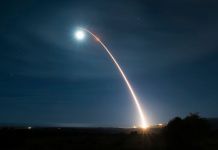United States Navy Secretary Kenneth Braithwaite has mentioned the need for a new specific fleet for the Indian Ocean Region, as the 7th Fleet stationed in Japan, might not be sufficient to deal with the growing Chinese threat in the region.
China Finds Answer To US’ B-21 Raider – The Mysterious JH-XX Stealth Fighter-Bomber – WATCH
The US Navy currently has seven fleets, each of which has its own area of operations. These fleets serve as the main operating units of the service around the world.
Recently, the US has been aggressively coming out in its posture against China, which is accused of practicing expansionist policies and suffocating the freedom of navigation on its side of the Pacific ocean. The moves and counter-moves by both sides fueled by the COVID-19 pandemic and the global anti-China sentiment have made the US and its allies come together closer.
Three days ago, the navies of India, Australia, Japan, and the United States commenced the Phase-2 of Malabar-2020 naval exercise, which is seen as the coming together of major powers of the Indo-Pacific against Beijing. All these countries have disputes with China and are concerned with the growing might of the Chinese Communist Party.
Recently, India and the United States also formalized the last foundational pact for their increased cooperation in the region including the military sphere. The Indian Navy, along with the US Navy has been actively taking part in the freedom of navigation operations in the South China Sea. It was even unveiled that the Indian Navy secretly dispatched an additional warship at the South China Sea to deter PLA Navy when hostilities suddenly peaked in June 2020.
A recent assessment by the US Department of Defense mentioned the aggressively growing Chinese fleet, which has now become the world’s largest navy in terms of surface vessel numbers. “The PRC [People’s Republic of China] has the largest navy in the world, with an overall battle force of approximately 350 ships and submarines including over 130 major surface combatants,” it said.

Beijing also unveiled a plan to make its military on a par with the United States’ in the next seven years. All these have prompted Washington to reconsider its plans to maintain its dominance over the seas.
As a result, the US Navy Secretary Braithwaite disclosed his plans to set up an additional fleet for the Indian Ocean Region. As of now, this area comes under the jurisdiction of the 7th Fleet stationed in Japan, which carries out operations in the Indo-Pacific.
“Braithwaite publicly called for setting up the additional fleet on Nov. 17, 2020, in remarks at the Naval Submarine League’s annual symposium, which is being held virtually this year due to the ongoing COVID-19 pandemic. He added that the plan is for this new unit to be designated U.S. 1st Fleet, which previously oversaw American naval operations in parts of the Western Pacific from 1947 to 1973,” Joseph Trevithick wrote in a piece for TheDrive.
“We want to stand up a new numbered fleet,” Braithwaite said. “And we want to put that numbered fleet in the crossroads between the Indian and the Pacific oceans, and we’re really going to have an INDOPACOM footprint.”
“We can’t just rely on the 7th Fleet in Japan. We have to look to our other allies and partners like Singapore, like India, and actually put a numbered fleet where it would be extremely relevant if, god forbid, we were to ever to get in any kind of a dust-up,” he added. “More importantly, it can provide a much more formidable deterrence.”
The move, if worked upon by the high brass, would provide the Allied navies of the United States with additional dedicated firepower in the Indian Ocean. The United States would have to work closely with the Indian Navy- which is the dominating naval power in its area of operations in the Indian Ocean.
The statements also point out to the level of seriousness with which Washington sees China. “The Chinese have shown their aggressiveness around the globe. Having just come from the High North (where he previously served as US Ambassador to Norway), Chinese presence in the Arctic is unprecedented.
Most recently I was on a trip to the Far East: every single one of our allies and partners is concerned about how aggressive the Chinese have been. I would argue with anybody that not since the War of 1812 has the United States and our sovereignty been under the kind of pressures that we see today,” said Braithwaite.
He also said that in the coming weeks he would be traveling to India to discuss both their security challenges and how the US Navy can uniquely help them, but also how India can help the US. Braithwaite made clear that the US alone cannot stand up to China and that the nations around the Pacific and around the globe needed to assist in pushing back militarily and economically if there was a chance for deterrence to work.
It’s also not clear where the 1st Fleet headquarters might eventually be situated. “We’re going to put it, if not Singapore right out of the chocks, we’re going to look to make it more expeditionary-oriented and move it across the Pacific until it is where our allies and partners see that it could best assist them as well as to assist us,” he added.
However, Navy spokesman Capt. J.D. Dorsey told USNI News on Nov. 18 that “no decisions have been made on timing or location for the establishment of an additional numbered fleet in the Indo Pacific. The Navy continues to review our organizational structure and force posture, in coordination with combatant commanders and our allies, to ensure we can most effectively meet the maritime challenges we face around the world.”
The US Navy’s previous 1st Fleet existed from just after World War II to the early 1970s.




